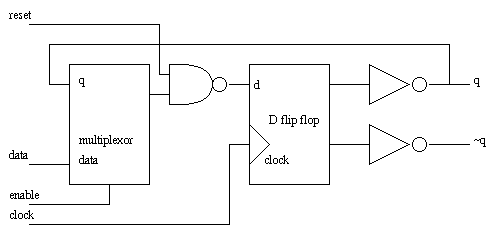
Keywords:
reg
default
value:
x
default
size:
1 bit
The fundamental difference between nets and registers is that registers have to be assigned values explicitly. That value is held until a new assignment is made. This property can, for example, be used to model a E-type flip flop as shown in figure below, with corresponding Verilog code given below.

module E_ff(q, data, enable, reset, clock);
output q;
input data, enable, reset, clock;
reg q;
always @(posedge clock) // whenever the clock makes a transition to 1
if (reset == 0)
q = 1'b0;
else if (enable==1)
q = data;
// implicitly : else q = q:
endmodule
As a contrast, if we go into a higher level module, for example the stimulus shown below, the output from the E_ff would have to be assigned as a net so that the E_ff module can drive its value. So now q is a wire.
module stimulus;
reg data, enable, clock, reset;
wire q;
initial begin
clock = 1'b0;
forever #5 clock = ~clock;
end
E_ff eff0(q, data, enable, reset, clock);
// as with 'c' in the previous section, the wire 'q' will now have its
// value driven into it by the E_ff module.
initial begin
reset = 1'b0;
#10 reset = 1'b1;
data = 1'b1;
#20 enable = 1;
#10 data = 1'b0;
#10 data = 1'b1;
#10 enable = 0;
#10 data = 1'b0;
#10 data = 1'b1;
#10 enable = 1;
#10 reset = 1'b0;
#30 $finish;
end
initial
$monitor($time, " q = %d", q);
endmodule